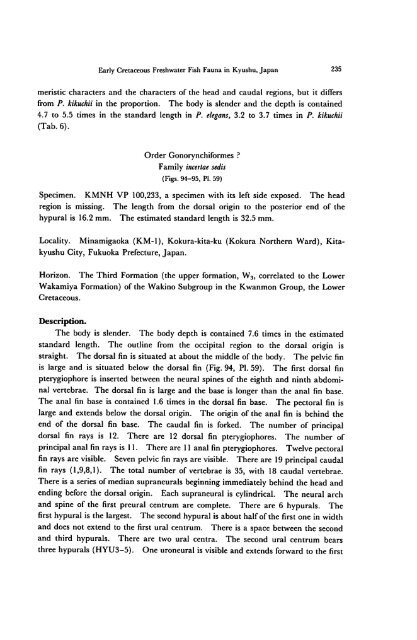Early Cretaceous Freshwater Fish Fauna in Kyushu, Japan
Early Cretaceous Freshwater Fish Fauna in Kyushu, Japan
Early Cretaceous Freshwater Fish Fauna in Kyushu, Japan
You also want an ePaper? Increase the reach of your titles
YUMPU automatically turns print PDFs into web optimized ePapers that Google loves.
<strong>Early</strong><strong>Cretaceous</strong> <strong>Freshwater</strong> <strong>Fish</strong> <strong>Fauna</strong> <strong>in</strong> <strong>Kyushu</strong>, <strong>Japan</strong> 235<br />
meristic characters and the characters of the head and caudal regions, but it differs<br />
from P. kikuchii <strong>in</strong> the proportion. The body is slender and the depth is conta<strong>in</strong>ed<br />
4.7 to 5.5 times <strong>in</strong> the standard length <strong>in</strong> P. elegans, 3.2 to 3.7 times <strong>in</strong> P. kikuchii<br />
(Tab. 6).<br />
Order Gonorynchiformes ?<br />
Family <strong>in</strong>certae sedis<br />
(Figs. 94-95, PI. 59)<br />
Specimen. KMNH VP 100,233, a specimen with its left side exposed. The head<br />
region is miss<strong>in</strong>g. The length from the dorsal orig<strong>in</strong> to the posterior end of the<br />
hypural is 16.2 mm. The estimated standard length is 32.5 mm.<br />
Locality. M<strong>in</strong>amigaoka (KM-1), Kokura-kita-ku (Kokura Northern Ward), Kita<br />
kyushu City, Fukuoka Prefecture, <strong>Japan</strong>.<br />
Horizon. The Third Formation (the upper formation, W3, correlated to the Lower<br />
Wakamiya Formation) of the Wak<strong>in</strong>o Subgroup <strong>in</strong> the Kwanmon Group, the Lower<br />
<strong>Cretaceous</strong>.<br />
Description.<br />
The body is slender. The body depth is conta<strong>in</strong>ed 7.6 times <strong>in</strong> the estimated<br />
standard length. The outl<strong>in</strong>e from the occipital region to the dorsal orig<strong>in</strong> is<br />
straight. The dorsal f<strong>in</strong> is situated at about the middle of the body. The pelvic f<strong>in</strong><br />
is large and is situated below the dorsal f<strong>in</strong> (Fig. 94, PI. 59). The first dorsal f<strong>in</strong><br />
pterygiophore is <strong>in</strong>serted between the neural sp<strong>in</strong>es of the eighth and n<strong>in</strong>th abdomi<br />
nal vertebrae. The dorsal f<strong>in</strong> is large and the base is longer than the anal f<strong>in</strong> base.<br />
The anal f<strong>in</strong> base is conta<strong>in</strong>ed 1.6 times <strong>in</strong> the dorsal f<strong>in</strong> base. The pectoral f<strong>in</strong> is<br />
large and extends below the dorsal orig<strong>in</strong>. The orig<strong>in</strong> of the anal f<strong>in</strong> is beh<strong>in</strong>d the<br />
end of the dorsal f<strong>in</strong> base. The caudal f<strong>in</strong> is forked. The number of pr<strong>in</strong>cipal<br />
dorsal f<strong>in</strong> rays is 12. There are 12 dorsal f<strong>in</strong> pterygiophores. The number of<br />
pr<strong>in</strong>cipal anal f<strong>in</strong> rays is 11. Thereare 11 anal f<strong>in</strong> pterygiophores. Twelve pectoral<br />
f<strong>in</strong> rays are visible. Seven pelvic f<strong>in</strong> rays are visible. There are 19 pr<strong>in</strong>cipal caudal<br />
f<strong>in</strong> rays (1,9,8,1). The total number of vertebrae is 35, with 18 caudal vertebrae.<br />
There is a series of median supraneurals beg<strong>in</strong>n<strong>in</strong>g immediately beh<strong>in</strong>d the head and<br />
end<strong>in</strong>g before the dorsal orig<strong>in</strong>. Each supraneural is cyl<strong>in</strong>drical. The neural arch<br />
and sp<strong>in</strong>e of the first preural centrum are complete. There are 6 hypurals. The<br />
first hypural is the largest. The second hypural is about half of the first one <strong>in</strong> width<br />
and does not extend to the first ural centrum. There is a space between the second<br />
and third hypurals. There are two ural centra. The second ural centrum bears<br />
three hypurals (HYU3-5). One uroneural is visible and extends forward to the first

















